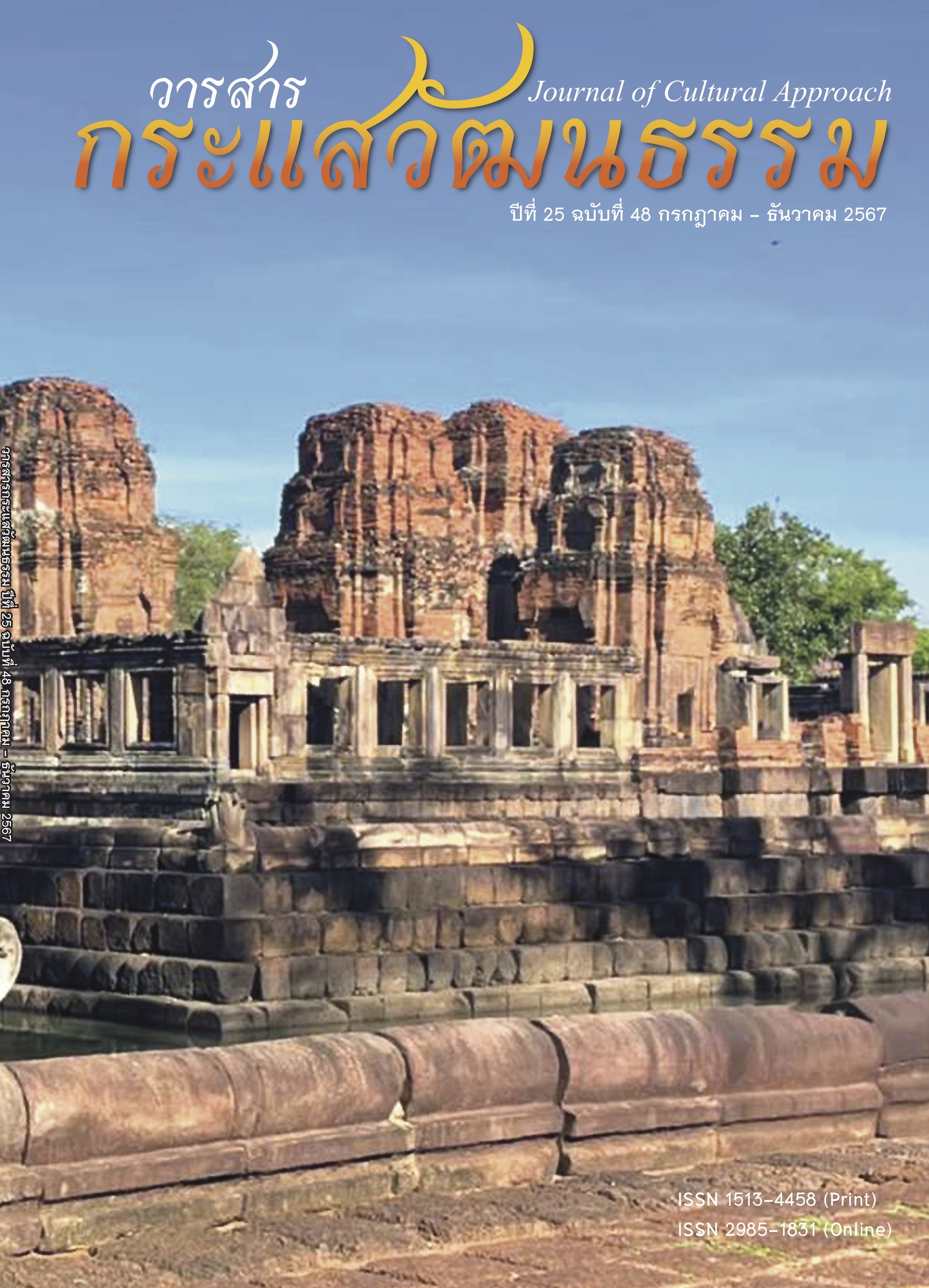การปลอมแปลงของตัวละครในนาฏกรรมไทย
Main Article Content
บทคัดย่อ
งานวิจัยเชิงคุณภาพเรื่องการปลอมแปลงของตัวละครในนาฏกรรมไทย มีวัตถุประสงค์เพื่อศึกษาแนวคิดการปลอมแปลงของตัวละครในนาฏกรรมไทย และเพื่อศึกษารูปแบบและองค์ประกอบของการปลอมแปลงตัวละครในนาฏกรรมไทย ผู้วิจัยใช้วิธีการวิเคราะห์ข้อมูลแบบสร้างข้อสรุป โดยการจำแนกชนิดข้อมูลและหาความสัมพันธ์ของข้อมูลด้วยวิธีอุปนัย จากนั้นจึงนํามาวิเคราะห์ข้อมูลร่วมกับการวิเคราะห์แบบเปรียบเทียบข้อมูลกับปรากฏการณ์อื่นที่เกิดขึ้น แล้วจึงหาความสัมพันธ์ของแต่ละกลุ่มข้อมูลและค้นหาคุณลักษณะร่วมของข้อมูลเพื่อนํามาสร้างเป็นข้อสรุปที่ใช้เป็นผลในการศึกษา สรุปวิธีการที่ใช้ในการวิเคราะห์ข้อมูลการเปรียบเทียบเหตุการณ์ต่าง ๆ จากข้อมูลภาคสนามโดยจำแนกข้อมูลออกเป็นประเภท ตามขอบเขตประเด็นต่าง ๆ ที่กำหนดไว้ในวัตถุประสงค์ ข้อมูลถูกนำเสนอด้วยคำอธิบายเชิงวิเคราะห์
ผลการวิจัยพบว่า "การปลอมตัว" หมายถึงการเปลี่ยนรูปลักษณ์โดยการเปลี่ยนชื่อ ทรงผม และเสื้อผ้า ขณะเดียวกันก็รักษาลักษณะอื่น ๆ เช่น เสียง บุคลิกภาพ และเพศไว้ไม่เปลี่ยนแปลง ในทางกลับกัน “การแปลงกาย” เกี่ยวข้องกับการเปลี่ยนแปลงโดยสิ้นเชิงในทุกด้านของตัวละคร รวมถึงรูปลักษณ์ น้ำเสียง บุคลิกภาพ และเพศ การแปลงกายมักเกิดจากพลังเหนือธรรมชาติหรือเทพเจ้าและเกิดการเปลี่ยนแปลงขึ้นได้ในระดับเซลล์ ในนาฏกรรมไทยมีวิธีการแสดงบทบาทของตัวละครที่ปลอมแปลง 3 ลำดับขั้น คือ 1) ก่อนปลอมแปลง 2) ขณะปลอมแปลง 3) เมื่อปลอมแปลงสำเร็จ การปลอมแปลงตัวละครในนาฏกรรมไทยมีองค์ประกอบต่าง ๆ ที่ทำให้การแสดงสมบูรณ์ สมจริงและชัดเจน องค์ประกอบเหล่านี้แบ่งได้เป็น 8 ประการ ได้แก่ 1) บทการแสดง 2) นักแสดง 3) บทเพลงและเครื่องดนตรีรวมทั้งเสียงที่ใช้ในการแสดง
4) ท่ารำ 5) พื้นที่การแสดง 6) อุปกรณ์ประกอบการแสดง 7) เครื่องแต่งกาย และ 8) การจัดแสง
การปลอมแปลงตัวตัวละครในนาฏกรรมไทยทำให้ผู้สร้างสรรค์นาฏกรรมสามารถตีความและสร้างสรรค์กระบวนรำได้หลากหลายรูปแบบ แสดงให้เห็นถึงวิถีและกลวิธีที่เป็นเอกลักษณ์ ทำให้การแสดงนาฏกรรมชุดนั้นมีความสวยงาม น่าสนใจ มีสีสัน หลายชุดการแสดงเป็นที่นิยมในการนำออกแสดงบ่อยครั้ง ผู้ชมเพลิดเพลินกับการชมศิลปินคนโปรดร่ายรำและแสดงบทบาทที่ซับซ้อนด้วยกระบวนรำที่ผูกขึ้นอย่างประณีต ถือเป็นความท้าทายสำหรับศิลปินในการถ่ายทอดบทบาทการแสดงตัวละครเหล่านั้น เพราะถึงแม้จะมีการเปลี่ยนแปลงรูปลักษณ์ภายนอกแต่แก่นแท้ของตัวละครไม่เปลี่ยนแปลง
Article Details

This work is licensed under a Creative Commons Attribution-NonCommercial-NoDerivatives 4.0 International License.
Proposed Creative Commons Copyright Notices
1. Proposed Policy for Journals That Offer Open Access
Authors who publish with this journal agree to the following terms:
- Authors retain copyright and grant the journal right of first publication with the work simultaneously licensed under a Creative Commons Attribution License that allows others to share the work with an acknowledgement of the work's authorship and initial publication in this journal.
- Authors are able to enter into separate, additional contractual arrangements for the non-exclusive distribution of the journal's published version of the work (e.g., post it to an institutional repository or publish it in a book), with an acknowledgement of its initial publication in this journal.
- Authors are permitted and encouraged to post their work online (e.g., in institutional repositories or on their website) prior to and during the submission process, as it can lead to productive exchanges, as well as earlier and greater citation of published work (See The Effect of Open Access).
Proposed Policy for Journals That Offer Delayed Open Access
Authors who publish with this journal agree to the following terms:
- Authors retain copyright and grant the journal right of first publication, with the work [SPECIFY PERIOD OF TIME] after publication simultaneously licensed under a Creative Commons Attribution License that allows others to share the work with an acknowledgement of the work's authorship and initial publication in this journal.
- Authors are able to enter into separate, additional contractual arrangements for the non-exclusive distribution of the journal's published version of the work (e.g., post it to an institutional repository or publish it in a book), with an acknowledgement of its initial publication in this journal.
- Authors are permitted and encouraged to post their work online (e.g., in institutional repositories or on their website) prior to and during the submission process, as it can lead to productive exchanges, as well as earlier and greater citation of published work (See The Effect of Open Access).
References
Alnawaiseh, A. & Al-Tarawneh, A. (2022). Disguise, Downclassing, and Social Invisibility in Shakespeare’s Measure for Measure and King Lear. Jordan Journal of Modern Languages and Literatures, 14(3), 607-621.
Andersen, M. Q. (2019). Experimentation through Disguise in Shakespearean Comedies. California State University.
Aungthonggumnerd, C. (2013). The Avatar in Hinduism. Humanities Journal, 20(1), 1-22.
Burawat, J. (2008). Principles of Surapankha's Performance in Opera-Oriented Dance Drama Ramakien. Chulalongkorn University.
Damrong Rajanubhab, H. R. H. (2003). Dance Drama. Matichon.
Dilokwanich, M. (2000). Dance and Drama in Asia. Thammasat University Press.
Hunter, M. L. (2019). Disguise, Transformation, and Revelation in Middle English Romances and Outlaw Ballads. University of Oxford.
Janninwong, N. & Limsakul, P. (2014). Choreography of Thai Performing Arts Movement of Acarn Suwanni Chalanukroa – the National Artist 1990. Journal of Fine and Applied Arts Chulalongkorn University, 1(1), 32-39.
Lakhonkhet, A. (2017). Analytical Study of Worships Benefits in the Theravada of Buddhism Philosophy. Dhammathas Academic Journal, 17(1), 147-156.
Makchui, W. (2007). Analysis of the Role of Transformation and Disguise of Characters from Plays in Royal Writings of King Rama II. Thaksin University.
Moore, S. C. (2017). The Importance of Disguise in the Middle English Romances. University of Tennessee.
Navasiri, P. (2005). Dance Movement of the Brahmin Characters in Lakorn-Nok. Chulalongkorn University.
Promrak, C. (2017). Comparative Analysis between Chui Chai the Posture Dances of Indrajit and Manop. Academic Journal Phranakhon Rajabhat University, 8(2), 259–270.
Satitsommon, N. & Limsakul, P. (2015). Techniques in the Performance of the Role of Disguised Female Demon in Lakhon Nok. Journal of Fine and Applied Arts Chulalongkorn University, 141-149.
Suphasetthasiri, P. (2002). Western drama. Santisiri Publishing.
Thupket, P. (2001). Dramatic Principles of Ketsuriyong Plaeng in Lakon Nok, Suwanahong. Chulalongkorn University.
Wirunrak, S. (2004). Evolution of Thai Dance in Rattanakosin. Chulalongkorn University Press.

